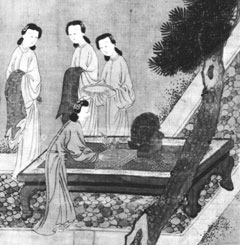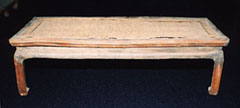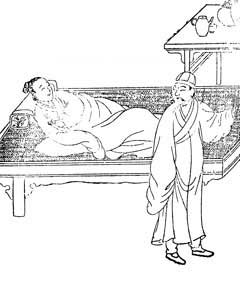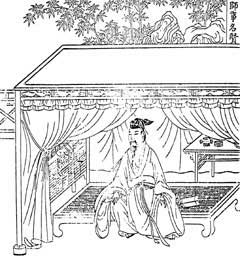|
 Open-frame daybeds were popularized during the Ming dynasty (1368-1644), and their use gradually eclipsed the old, box-style platform. Traditional styles included simianping and waisted forms with cabriole legs or horsefeet. Open-frame daybeds were popularized during the Ming dynasty (1368-1644), and their use gradually eclipsed the old, box-style platform. Traditional styles included simianping and waisted forms with cabriole legs or horsefeet.
|
|
 A miniature wooden daybed found in the tomb of Pan Yunzheng (d. 1589) near Shanghai reflects a classical 'waisted corner-leg' -style typical of the late Ming period A miniature wooden daybed found in the tomb of Pan Yunzheng (d. 1589) near Shanghai reflects a classical 'waisted corner-leg' -style typical of the late Ming period
|
|
 Daybeds of 'recessed-leg' style were also typical of the late Ming period, including both those of round-leg style as well a those with mitered bridle joints and legs shaped with flanges. Daybeds of 'recessed-leg' style were also typical of the late Ming period, including both those of round-leg style as well a those with mitered bridle joints and legs shaped with flanges.
|
|
 Being relatively lightweight, the daybed was well-suited for impromptu gatherings, and was often arranged with other furnishings on a terrace or in the garden where fresh air and natural impressions could be enjoyed. Being relatively lightweight, the daybed was well-suited for impromptu gatherings, and was often arranged with other furnishings on a terrace or in the garden where fresh air and natural impressions could be enjoyed.
|
|
 In a makeshift study arranged on a garden terrace, the daybed served as a place for quiet relaxation and contemplative meditation or as a platform from which to engage in lofty conversation. Such tented arrangements also provided a comfortable place to sleep during the hot summers nights. In a makeshift study arranged on a garden terrace, the daybed served as a place for quiet relaxation and contemplative meditation or as a platform from which to engage in lofty conversation. Such tented arrangements also provided a comfortable place to sleep during the hot summers nights.
|
|
 The refined gentleman also found idle pleasure playing the qin while seated upon a daybed arranged in a garden pavilion. The refined gentleman also found idle pleasure playing the qin while seated upon a daybed arranged in a garden pavilion.
|
|
Writing in the early 17th century, Wen Zhenheng recommended a simple daybed (ta) for a gentleman's sleeping quarters; his suggested arrangement—with a couple of stools and a small table set to the side—corresponds closely to scene painted by Qiu Ying some 50 years earlier.
|
 |
|
Therein, a gentleman relaxes leisurely upon on a simianping daybed, and while reclining against a backrest, looks out upon an enclosed private garden.
|
|
 Open-frame daybeds were popularized during the Ming dynasty (1368-1644), and their use gradually eclipsed the old, box-style platform. Traditional styles included simianping and waisted forms with cabriole legs or horsefeet.
Open-frame daybeds were popularized during the Ming dynasty (1368-1644), and their use gradually eclipsed the old, box-style platform. Traditional styles included simianping and waisted forms with cabriole legs or horsefeet.